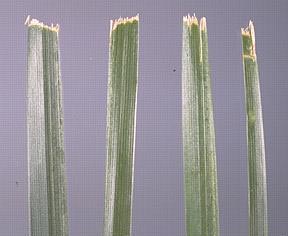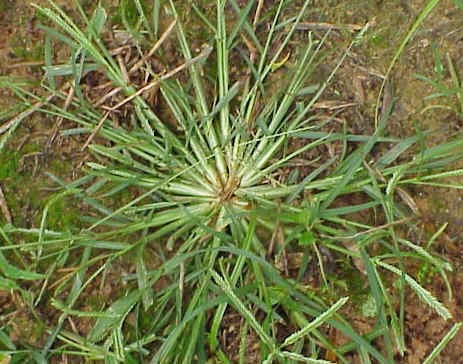Spring Tune-up for Your Lawn
By Sharon V. Smith, former Fairfax Master Gardener
If you are anything like me, you are becoming anxious to work outside. You may be wondering what activities should be on your Lawn “To Do” List. For starters, if you can’t remember the last time you did a soil test, this is the time to do one. Then, file your report and repeat the test in three years. You can pick up soil test kits from your local Virginia Cooperative Extension Office and at your local libraries. When you are testing your lawn, remember you will need two test kits, one for the front yard and one for the back. With every kit, there will be instructions for obtaining the soil samples and the mailing address of the Virginia Tech Soil Testing Lab.
The lab will perform an analysis of your lawn’s soil acidity and nutrient contents. Upon receiving your samples, they will send you their recommendations approximately three days later about how to correct the deficiencies in your soil. It is amazing to think that they test over 50,000 samples each year.

Ragged grass blades from dull mover blade
While you are waiting for your soil test results, use the time to inspect your lawn mower. Spending the time now will result in better mower performance and a healthier lawn. With your service manual in hand, review the steps to getting your mower ready for the season. In general, replacing the spark plug, getting the blades sharpened and balanced, cleaning the underside of the mower deck to remove any decomposing grass buildup, checking the belts and changing most fluids and filters will optimize mower performance while extending the life of the engine.
I recommend looking on our website for the Lawn Care Calendar in our Reference Publications that corresponds to the type of grass you have. Or you can drop by one of our plant clinics held at Farmer’s Markets and local libraries, beginning in May, to pick one up. I put my calendar on my refrigerator, and suggest that you put yours somewhere easy to find, since you will be using it year after year for reference. The calendar is easy to follow and uses bar lines to indicate the best month(s) to perform which lawn maintenance activity.

Goosegrass
Pre-emergence herbicides must be incorporated into the soil surface through irrigation or rainfall before the products can affect target weeds. This step is critical in herbicide management. In general, you will find most labels recommending you apply one-half inch of water within two to three days of pre-emergent application to improve the effectiveness of the treatment. Yet, please check the herbicide label you have for specific instructions on how much irrigation is needed after your application.
Remember also that if the chemical barrier is not incorporated into the soil deep enough through proper irrigation, the net effect is that the chemical barrier will not be deep. Therefore, weeds will germinate under the thin chemical barrier and push up through it. If you miss a spot in your application, you have provided a gap for weeds to grow. The same goes for de-thatching and aerating after applying the herbicide. They too can also break the chemical barrier of the herbicide. Application uniformity is key to creating a complete barrier.
Some common trade names found at your local garden centers include Barricade (prodiamine), Dimension (dithiopyr) and Scotts Halts (pendimethalin). Reseeding cannot be done for three to four months after herbicide application. Therefore, if you are seeding a spring lawn, use Tupersan (siduron) with a starter fertilizer. Most commonly formulated herbicides will also contain a lawn fertilizer.
Please use chemicals (herbicides) with caution, and always read the labels and directions carefully. To dispose of any chemical or chemical container in a way that is inconsistent with its label directions is against the law. Please do not leave the chemical pellets on your hardscapes (driveways, sidewalks, patios) where water runoff could occur and eventually enter the Chesapeake Bay or the Potomac River, harming the fish.
Since 80 percent of all weedy species can be eliminated from your lawn with regular, proper mowing, having a well-serviced mower is paramount. Remember, if you cut your lawn too short (more than one-third of the lawn’s height), there isn’t enough foliage to sustain healthy growth, and your lawn will start to decline and become thin. When mowing, leave the clippings on the lawn. This practice will provide a ready source of fertilizer and promote root growth. Think of it as “grass cycling.”
If you follow these recommendations, you are moving closer to achieving that healthy, beautiful lawn you always wanted. Weeds will always be there, yet never give them the upper hand because the very best type of weed control is, you guessed it, a healthy lawn.
References
• Establishing Lawns, Virginia Gardener, Virginia Cooperative Extension
• March Lawn Care, March 2015 – Vol 1 No.3, Piedmont Master Gardeners
• Service Mowers Now Before Springing Them into Action Next Season, Mike Goatley, January 5, 2013,
Virginia Cooperative Extension
• Virginia Soil Testing Lab, Virginia Tech
• Top 5 Weeds – Headaches in Our Summer Lawns, Sharon V. Smith, Fairfax Gardening
…updated 2024